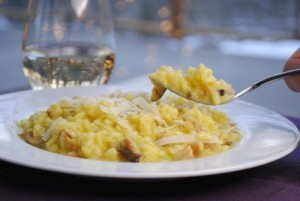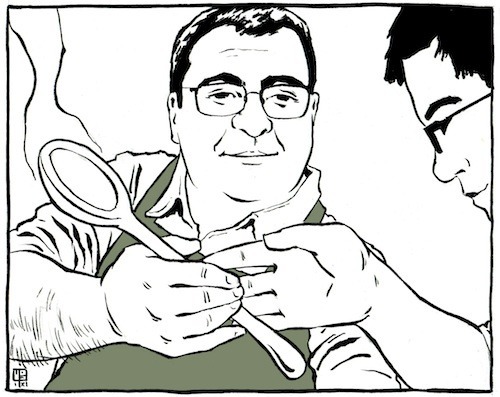Pam Anderson's Blog, page 75
January 26, 2011
The Provencal

Lavender-Infused Gin

Vermouth De Provence

Simple Syrup

January 24, 2011
Rosti Potatoes—Made by Him

Rosti Potatoes

January 21, 2011
Spiced Chai Concentrate

January 19, 2011
Wild Mushroom Risotto
 I usually use an exotic dried mushroom blend (from Costco), but you can use any dried mushrooms you like. You can also use sautéed fresh mushrooms or some of each. I use a mortar and pestle to grind the white pepper. If you don't have one, just put the peppercorns in a plastic bag and use a heavy object to crush them.
I usually use an exotic dried mushroom blend (from Costco), but you can use any dried mushrooms you like. You can also use sautéed fresh mushrooms or some of each. I use a mortar and pestle to grind the white pepper. If you don't have one, just put the peppercorns in a plastic bag and use a heavy object to crush them.
Serves 8 as a first course, and 6 as a main.
1 cup dried mushrooms
1 quart plus 2 cups low-salt chicken broth, more if necessary
Pinch saffron (optional)
2 tablespoons olive oil
1 medium-large onion, cut into small dice
Kosher salt, to taste
2 garlic cloves, minced
10 white peppercorns, ground to a fine powder
2 cups (1 pound) Arborio rice
1 cup dry white wine (my go-to is an inexpensive Chilean sauvignon blanc)
1 cup grated Parmigiano Reggiano
1 tablespoon unsalted butter
Put the dried mushrooms in a heatproof bowl or large Pyrex liquid measure. Add 3 cups of boiling water and let the mushrooms steep until they are fully re-hydrated and soft. Remove the mushrooms and roughly chop them; reserve 2 cups of the mushroom liquid.
Heat the chicken broth and the reserved mushroom liquid in a large saucepan over medium heat. Add a large pinch of saffron, cover, and bring to a simmer. Reduce heat to low and keep the liquid barely simmering throughout the risotto preparation.
Heat the olive oil in a Dutch oven or large, heavy-bottomed pot over medium heat. Add the onion and sprinkle lightly with kosher salt; sauté until soft and translucent, about 5 minutes. Add garlic; continue to cook until fragrant, about another minute. Stir in ground white pepper, and then the rice, stirring constantly to coat and toast the rice, about a minute. Add white wine; simmer, stirring constantly, until almost absorbed.
Add one ladleful of the hot stock; stir constantly until most of it has been absorbed (when you drag your wooden spoon across the bottom of the pot, you shouldn't see any excess liquid). Add another ladleful of stock; stir constantly until it, too, has all been absorbed. Repeat this process ladle by ladle until the grains of rice are tender and the risotto is very creamy, 20 to 30 minutes. It is important to remember to stir continuously so the rice doesn't stick or burn and the creamy texture develops. If your arm gets tired, switch arms or find someone to take over.
All rice is different, and risotto is not an exact science. You will probably use all the stock, but if your risotto is done before your saucepan is empty, don't worry. Similarly, be prepared to add more stock (or some of that extra mushroom liquid) to the saucepan if you think you'll need more. Remember that for the rice to continue cooking, the stock that you add needs to be hot.
When the risotto is done, add the Parmigiano and the butter and stir to combine. Season to taste with salt and more white pepper, if you like. Serve hot.

My Father's Risotto
Guest post by Anthony Damelio (we call him Tony), Sharon's fiancé.
I love making risotto: not just the possible ingredients or the finished product but also, and perhaps most importantly, the process. Growing up, I watched my father prepare it often for formal occasions and normal dinners alike, and so I make it as much as possible, especially when a special meal comes around.
One time, though, my penchant for risotto failed me miserably. I was living with six others in Tucson, Arizona, and it was late June in the desert—not a cool place to be. My housemates and I had a special meal to prepare for the new pastor at our church who was coming over. I scanned the pantry shelves, found some Arborio rice that needed to be used, and remembered an online recipe I had seen for strawberry risotto. Since we had some frozen bags of ripe strawberries, I thought I'd had a divine revelation: a fruity yet savory dish to be served on a hot desert evening.
Wow, was I wrong. Being a devotee of good risotto, I was appalled at the finished product. It was lacking in depth, the strawberries were flavorless and out of place, and the hot rice didn't exactly soothe our sweating foreheads. It wasn't a bad recipe, per se; the dish just tanked, especially alongside some other significant lapses in culinary judgment (ask me later about the gooey, poorly fried okra). Needless to say, I was embarrassed.
Part of me was so ashamed because I love making risotto for other people, something almost hard-wired into my culinary limbic system. When I was growing up, my father would often start the risotto process just as guests began to arrive, so that he could entertain in the kitchen. My dad, a gregarious Italian-American, loves to cook with and for people, especially Italian-inspired food. For him, risotto was a great way to keep the party going around the stove while he continued to cook. Plus, risotto doesn't require much technical prep or complicated presentation work.
The actual hard work comes from sticking to the process, something my father reveres. To start, he makes sure the extra virgin olive oil is hot and then begins sautéing his onions. Right before they caramelize, he adds the garlic and the rice (to toast it), before deglazing with a good splash of white wine. Then, making sure the stock is ready to go, he adds it one ladle at a time. (Sometimes I get lazy and add two at a time so I can run do something else around the kitchen, but usually my father is more patient). At this point, there's no turning back. You have to keep stirring constantly so the rice doesn't stick. Usually he would press me into service at this point, making sure I wouldn't stop stirring. You have to resist the urge to turn the heat up and rush it; the rice will do its magic—give off that lovely creaminess—and will be ready with its last touches of Parmigiano and a pad of butter.
When you're finally done stirring and you taste the first bite, you can always tell a risotto that's been tended with care and love. I've made many different risottos in my life; and though I'm always eager to try new ingredients, my strawberry debacle haunts my culinary dreams, chastening any bold plans I might have. Thus, I often fall back on the timeless ingredients—seared shrimp, champagne, simple saffron—though my favorite is wild mushroom, made with dried mushrooms and saffron broth. But no matter the ingredients, I always try to model my father's techniques, both in the dish and with the guests.

January 17, 2011
Unconditional Hospitality
I can't decide whether I'm proud or embarrassed that we so infrequently frequent restaurants. It's not that we're saving money by eating in. Every time I open my bulging fridge or admire my racks of wine, I am reminded of just how many times we could have gone out for dinner for the cost of all this.
It's that we cook for a living, and there are always so many good things to try—so many tempting leftovers—there's little reason to go out. It's a value thing too. With a little effort and know-how, we mostly eat restaurant-quality food at home. The kids roll their eyes when David and I speculate the restaurant price for one of my appetizers or one of his wine picks.
Nevertheless, we still dine out. But rather than do what normal people do—enjoy a cocktail and nibble before heading out to dinner—we go out for appetizers and drinks and then come home for dinner! Which is how we ended up at Bolete in Bethlehem, Pennsylvania the other night.
I knew the restaurant by reputation. I had visited their website, practically memorized their menu, and knew Chef Lee Chizmar and wife, Erin Shea's farm-to-table philosophy. It was past time for a visit and so Three Many Cooks and significant others planned a fun outing—a matinee, drinks and appetizers at Bolete, followed by an osso bucco dinner at home.
I knew Bolete's Bar wasn't huge and six of us at 6:30 on a Friday night might overwhelm, so I called ahead. The woman on the other end took my information and pleasantly responded. "We'll call back if we can't accommodate." As we emerged from the theatre, there was a message from Bolete. Damn, I thought, they can't pull it off. Instead it was, "We'd love to have you—see you at 6:30."
We arrive at the bustling restaurant and find the bar full. No worries. They guide us to their dining room, seating us at their best table, perfectly aware we are not here for a full meal.
We each order one of their fun artisan cocktails and a perfectly executed appetizer, but since we were in the dining room, they also brought us a basket of their signature warm Cream Dinner Rolls with Fresh Thyme. The drinks and appetizers were flawless, but it was the rolls we were taken with. Light as a cotton puff, egg-rich like a brioche but weightless, fragrant, warm. In an odd way, these Cream Dinner Rolls stole the show. I think it was because they felt like a gift. We got them because they seated us in the dining room and gave us a big table and treated us like home guests. Even though we were there "just for a drink." Their website spoke of "unconditional hospitality." I got it.

Pam Anderson's Blog
- Pam Anderson's profile
- 13 followers





